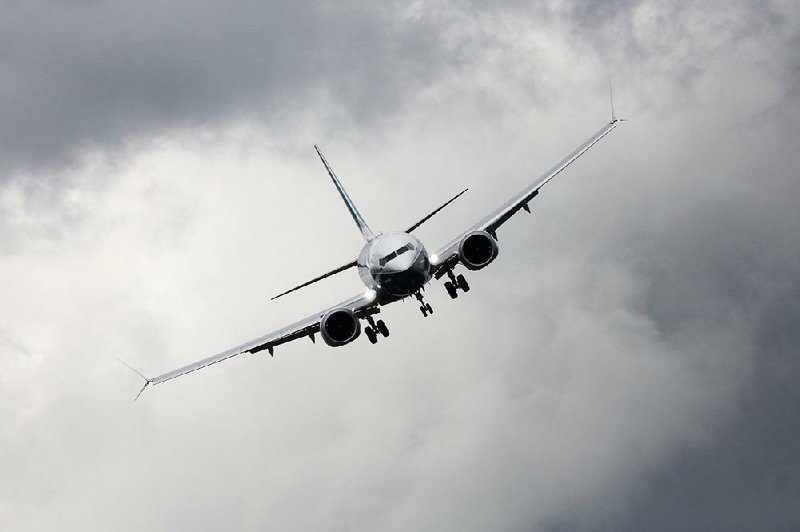The smallest aircraft made by Boeing Co. and Airbus Group SE are about to find a new role operating trans-Atlantic routes that were previously the preserve of some of the world's biggest planes.
The re-engined 737 Max and A320neo jets are 15 percent more fuel efficient to cut costs on the shortest inter-city flights. At the same time the upgrade has added about 500 miles to their range -- just enough to allow the narrow-bodied planes to span the 3,000 miles between the eastern U.S. and western Europe.
While eight hours on a 130-foot plane with three toilets and one gangway might not immediately appeal to travelers used to the spacious cabins of an Airbus A380, airlines say the smaller jets will open up direct routes that wouldn't otherwise be viable. That would do away with the need to switch between flights at a busy hub. At the same time people can look forward to competitive fares as carriers seek out smaller airports where access charges are lower.
Norwegian Air Shuttle ASA, JetBlue Airways Corp. and Portugal's TAP are among airlines buying the jets for trans-Atlantic routes, with Norwegian Air set to lead the way when it becomes one of the first carriers to get Boeing's Max 8 next year. Its initial flights may link Edinburgh and Birmingham in the United Kingdom and Cork and Shannon in Ireland to smaller airports in northeast U.S.
"The Max is very competitive," Norwegian Air CEO Bjorn Kjos said in an interview in London. "It has huge potential from the smaller cities along the Atlantic coast. But you can't go into New York as you do with wide-bodies. You must target airports with a totally different cost structure."
Boeing's 757, the world's longest single-aisle airliner with around 200 seats and a range in excess of 4,000 miles, has been crossing the Atlantic for years, with companies including United Continental Holdings Inc. still deploying the model on routes such as Newark, N.J., to Birmingham, England.
Production ceased in 2004, however, leaving those 757s still flying in the twilight of their lives and with fuel consumption way in excess of modern jets.
The 737 and A320, by contrast, were designed for much shorter flights, with the original 737-100 seating just 85 people and limited to trips of about 1,200 miles. While ranges have increased, the 3,300-mile reach of the 737-800 and -900 is insufficient for fully laden operations on trans-Atlantic routes where jets must carry enough reserve fuel to fly about 500 miles in an emergency.
A handful of carriers operate services at reduced capacity, which cuts the weight of a plane and increases its range, with SAS AB serving Boston from Copenhagen using an 86-seat 737-700 and British Airways connecting London City airport and New York with an Airbus A318 carrying just 32 passengers.
The only current trans-Atlantic 737 or A320 flights with a near-normal load are flown by Canada's WestJet Airlines Ltd. and link St. John's, Newfoundland, with Dublin -- distance 2,000 miles -- and Halifax, Nova Scotia, with Glasgow in Scotland. The 737-700s used have 136 seats.
The U.K. and Irish routes planned for Norwegian's 189-seat Max 8s will span about 3,000 miles. Subsequent flights could serve Stavanger, Trondheim and Bergen in Norway and Aalborg in Denmark, though they'll likely involve a long-range version of Airbus' A321neo known as the LR and able to fly more than 4,000 miles using extra fuel tanks, spokesman Lasse Sandaker-Nielsen said. Norwegian ordered 30 of the planes with 220 seats in a single class in July.
JetBlue and TAP also plan to deploy the model, which is due to be available from 2019. The U.S. carrier has agreed to buy 30 A321neos with an option to take some as LR variants, saying it wants an aircraft with "trans-Atlantic range." TAP has orders for 10 A321neo-LRs, saying it could use them to serve Brazil and possibly the U.S. Its Lisbon base is about 3,500 miles from both New York and Recife, the South American country's sixth-largest city.
With the A321neo-LR emerging as a favored successor to the 757, Boeing is studying designs for a stretch of its biggest Max 9 -- dubbed the Max 10 -- that would offer much of the range and payload of the A321 and could be ready by the decade's end, or a more elaborate revamp using the larger engines developed for the Airbus jet. It's also working on a new family of midrange aircraft that would debut about five years later, Chief Executive Officer Dennis Muilenburg said Wednesday.
Whatever the outcome, passengers seem certain to be making longer trips on the smallest class of jetliners in coming years.
"For the moment we haven't really got the planes out there," said Yan Derocles, an analyst at Oddo Securites in Paris. "But they're coming."
Business on 09/16/2016

